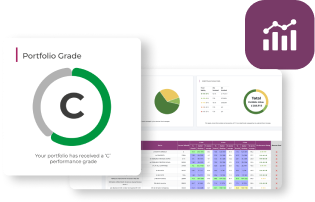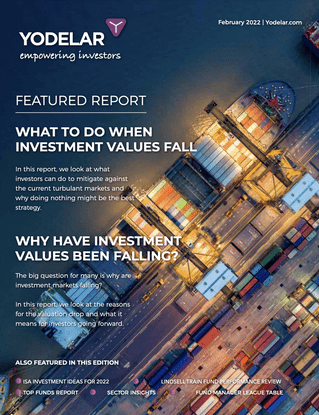-
A portfolio review exposes structural inefficiencies that performance figures alone can’t reveal, such as duplication, drift, and cost imbalance.
-
Even portfolios that appear well diversified often contain overlapping holdings that limit true diversification and increase risk concentration.
-
Market movements can alter portfolio risk over time, making regular reviews essential to ensure continued alignment with investor objectives.
-
Analysing a portfolio by sector averages helps identify which funds have added genuine long-term value and which may be holding performance back.
Most investors judge their portfolio by one simple measure: performance. If the figures look positive, the assumption is that everything is working as it should. Yet, performance alone rarely tells the full story.
A portfolio can appear successful on the surface while concealing inefficiencies that quietly restrict growth, distort risk, or increase costs. A detailed review looks beyond the headline numbers to reveal the structure and behaviour of the portfolio itself — showing not just how much it has grown, but how that growth has been achieved.
When carried out correctly, a portfolio review acts as a diagnostic rather than a scorecard. It helps investors understand whether their holdings remain appropriate for their objectives and risk tolerance, and whether their money is working as efficiently as possible within changing market conditions.
At Yodelar, years of portfolio analysis have shown that even experienced investors often hold collections of funds that look diversified but in practice are anything but. Only through review can these hidden inefficiencies be identified and addressed — and it is this deeper level of understanding that often makes the greatest difference to long-term outcomes.
Spotting Structural Weaknesses
Performance figures alone cannot reveal the underlying factors that drive success or shortfall. Portfolios that appear strong in absolute terms can still be inefficient when compared against their sector averages or similar-risk alternatives.
Watch Video: The Portfolio Pitfalls Investors Can Miss
This short insight illustrates the structural challenges that often undermine portfolio efficiency — such as duplication, risk imbalance, and excessive concentration. These issues are not always visible from performance data alone but become evident through detailed sector analysis.
What a Detailed Review Reveals
A thorough portfolio review often reveals underlying structural patterns that are not immediately visible from performance figures alone. Among the most common are three recurring weaknesses that can quietly erode efficiency and limit long-term results.
Duplication and False Diversification
Owning multiple funds does not necessarily mean diversification. Many investors hold several global or UK equity funds that invest in the same large-cap companies, such as Microsoft, Apple, and AstraZeneca. This repetition creates concentrated exposure under the illusion of diversification. A detailed review quantifies this overlap and measures how much of the portfolio’s growth has come from repeated holdings rather than genuine spread.
Risk Drift and Misalignment
Market movements gradually shift portfolio risk. Equity-heavy portfolios can become higher risk than intended after sustained market growth, while defensive portfolios can drift too far from growth assets after downturns. A review highlights this drift, providing clarity on whether the portfolio’s current positioning still matches the investor’s stated risk tolerance.
Cost Inefficiencies
Charges are an unavoidable element of investing, but excessive costs are not. Many investors unknowingly hold funds with higher-than-average ongoing charges or pay additional platform and management fees that dilute returns. Identifying where costs exceed value is a key step in improving overall portfolio efficiency.
Understanding the Structure Behind Performance
Portfolio performance is only one outcome of a much broader set of structural dynamics. The composition of a portfolio — its blend of funds, asset classes, and geographical exposures — determines both its potential and its vulnerability.
Watch Video: Building the Right Portfolio
This short visual overview demonstrates the principles of balance and diversification that underpin effective portfolio construction. It highlights how asset allocation, risk alignment, and fund selection combine to create the foundations of a well-structured investment strategy.
A review that focuses only on returns misses these crucial elements. The purpose of analysis is to understand why a portfolio has performed as it has, and whether that performance was achieved efficiently relative to the level of risk taken.
Evaluating Portfolio Efficiency Over Time
The real value of a portfolio review lies not in comparing hypothetical outcomes but in understanding why performance has been what it is. Efficiency is revealed through structure, not speculation.
A review that examines fund selection, sector exposure, and risk consistency over time provides a factual picture of how effectively a portfolio has been managed. It highlights whether the current mix of funds continues to justify its position and whether performance has been driven by consistent quality or by short-term trends.
This type of analysis doesn’t predict returns; it clarifies whether a portfolio has been efficient, diversified, and aligned with its intended risk profile — the foundations required for long-term success.
Staying Proactive, Not Reactive
Market conditions, fund management styles, and sector trends evolve constantly. A portfolio that was suitable three years ago may now carry unintended concentrations or risk exposure simply due to market movement. Without regular assessment, portfolios can drift away from their original design — sometimes significantly — leaving investors either overexposed to risk or too defensively positioned to capture opportunity.
Periodic reviews enable investors to identify and address these changes early. They ensure portfolios remain structured to reflect both current market conditions and the investor’s long-term objectives.
Proactive oversight is not about chasing short-term performance; it’s about maintaining control, making timely adjustments, and ensuring each part of the portfolio continues to serve its intended purpose. Over time, this disciplined process contributes more to investment success than any single market event or fund choice.
Conclusion
A comprehensive portfolio review reveals much more than performance. It provides the clarity investors need to understand how effectively their portfolio has been working and where adjustments could strengthen its long-term position.
For many investors, it is the first time they can see the full picture — how each fund has contributed to results, whether the overall structure still reflects their objectives, and whether the balance between cost, risk, and return remains appropriate.
The value of a review lies in the perspective it brings. It separates what has genuinely driven performance from what has simply benefited from market momentum, highlighting the parts of a portfolio that have delivered lasting value and those that may now hold it back.
In a changing market environment, portfolios require ongoing care and attention. Regular analysis ensures investors remain in control, confident that their portfolio is structured to adapt to market cycles and aligned with the goals it was designed to achieve.
Those who take the time to understand how their portfolio is performing beneath the surface are better placed to make meaningful improvements — and to ensure every part of their investment strategy is working with purpose.
This article is provided for information purposes only and does not constitute investment advice or a recommendation to buy, sell, or otherwise engage in any investment activity. Past performance is not a guide to future returns. The value of investments can go down as well as up, and investors may not get back the amount originally invested.

















